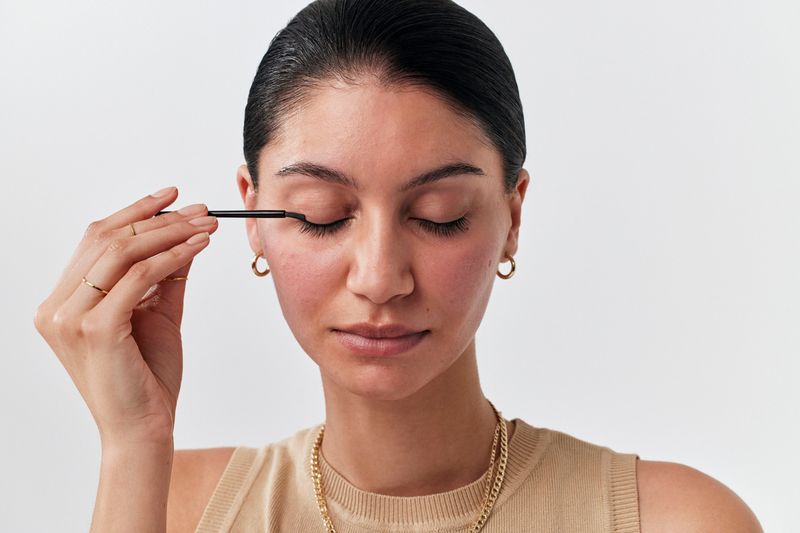Has prescription eyelash treatment caught your eye? You're not alone. With so many lash enhancement options out there — including non-prescription serums or extensions — it can be difficult to figure out what’s a fact and what’s fiction.
That’s why Ro Derm, previously known as Rory, works with affiliated US-licensed healthcare providers to help people access science-backed treatments, if appropriate. Offerings include personalized prescription skincare and Latisse (bimatoprost ophthalmic solution), the first and only FDA-approved treatment that’s clinically proven to make eyelashes longer, fuller, and darker. Below, their expert team addresses common misconceptions about Latisse and helps set the record straight.
FICTION
There’s a good chance Latisse will change your eye color.
FACT
In clinical trials for Lumigan (a glaucoma medication containing bimatoprost, the same active ingredient in Latisse), 1-2% of users experienced some brown darkening of the colored part (iris) of their eye. It’s important to note, however, that glaucoma patients apply the medication DIRECTLY into their eyes, which is not the case for Latisse.
While this change is potentially possible when using Latisse and likely permanent, there were no cases of eye color change noted in Latisse clinical trials. Still, it's important to know all the potential side effects of Latisse, and iris pigmentation, although rare, may be one of them. If Latisse is applied exactly as directed (i.e., at the base of the upper eyelid lash line using the provided applicator and not into your eye), this color change is not likely to happen. Remember to wipe away any excess solution to further reduce the risk of getting it into your eye.
FICTION
Latisse causes unwanted non-eyelash hair growth if it makes contact with your skin.
FACT
There’s a potential for unwanted hair growth if Latisse makes repeated—emphasis on repeated—contact with your skin, but using it exactly as directed makes this hair growth unlikely to happen.
Apply Latisse only to the upper eyelid lash line at the base of the eyelashes (never on the lower lash line) and use the sterile applicators that come with the solution. Blot any excess Latisse from your eyelid to prevent it from running onto your cheek or other areas.
FICTION
You can’t be prescribed authentic Latisse online.
FACT
You probably have a lot of things on your plate, and worrying about the authenticity of your medication shouldn’t be one of them. Ro Derm makes it convenient to connect with a US-licensed healthcare professional and receive real prescription medication. Ro Derm purchases Latisse directly from the manufacturer, Allergan, to make sure it’s legit.
FICTION
Latisse is not worth the cost.
FACT
While Latisse may cause some sticker shock upfront, it’s important to put the price into perspective. The main factors behind Latisse's higher price point, especially when compared to non-prescription lash growth serums, is that it's FDA-approved and clinically proven to work. At the end of Latisse's 16-week clinical trial, users' lashes were an average of 25% longer, 106% fuller, and 18% darker. Plus, 78% of users experienced eyelash enhancement.
If we think about Latisse’s price per application, it comes out to $1.41 per use for each eye for your first month on a 3 mL plan, or $0.96 per use for each eye for your first month on a 5 mL plan. To put it another way, think about Latisse versus eyelash extensions. In NYC, eyelash extensions can cost an average of $150-$200 for an initial full set, plus $50-$70 for monthly refills and maintenance. With Ro Derm, you’ll pay $99 for your first monthly shipment on a 3 mL plan, or $134 for your first quarterly shipment on a 5 mL plan.
Want to see if Latisse is right for you? Start an online visit with a US-licensed healthcare professional at https://derm.ro.co/latisse. Latisse is available by prescription only.
Important Safety Information: Latisse is an FDA-approved treatment to grow eyelashes for people with inadequate lashes. If you use prescription products for eye pressure problems, or have had eye problems/surgery, consult your doctor before using. Latisse may cause eyelid skin darkening, which may be reversible. The active ingredient in Latisse (bimatoprost) has caused darkening of the colored part of the eye (the iris), which is likely permanent. Remove contact lenses before applying Latisse and reinsert 15 minutes after applying. Apply only at the base of the upper lashes. Do not apply to the lower lid. Hair may grow outside the treatment area if it comes into contact with Latisse. Common side effects include itchy and red eyes. Lashes gradually return to previous appearance if Latisse is discontinued. Do not use Latisse if you are allergic to one of its ingredients. For more, see full Important Safety Information here.

